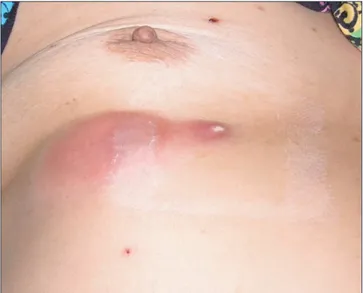Empyema Necessitatis in a Patient on Peritoneal Dialysis
In Ho Moh, M.D.
1, Young-Ki Lee, M.D.
1, Hee Joon Kim, M.D.
1, Hyun Yon Jung, M.D.
1, Jae Hyun Park, M.D.
1, Hye-Kyung Ahn, M.D.
2and Jung-Woo Noh, M.D.
11
Department of Internal Medicine, Hallym Kidney Research Institute,
2Department of Pathology, Hallym University College of Medicine, Seoul, Korea
Empyema necessitatis is a rare complication of an empyema. Although the incidence is thought to be decreased in the post-antibiotic era, immunocompromised patients such as patients with chronic kidney disease on dialysis are still at a higher risk. A 56-year-old woman on peritoneal dialysis presented with an enlarging mass on the right anterior chest wall.
The chest computed tomography scan revealed an empyema necessitatis and the histopathologic findings revealed a granulomatous inflammation with caseation necrosis. The patient was treated with anti-tuberculous medication.
Keywords: Empyema; Mycobacterium tuberculosis; Peritoneal Dialysis
Case Report
A 56-year-old woman presented with an enlarging soft mass on right anterior chest wall with pain lasting for 2 months.
There were no symptoms of fever, dyspnea, or cough. She denied recent chest trauma or exposure to tuberculosis. She was diagnosed with chronic kidney disease seven years ago and has been on peritoneal dialysis for four years. Her medical history was remarkable of hypertension, diabetes mellitus and hypothyroidism on medication. Vital signs on admission were blood pressure 134/68 mm Hg, temperature 36.9
oC, pulse rate 95 beats per minute, and respiratory rate 20 breaths per min- ute. Physical examination revealed a pink erythematous, cold, soft, tender, subcutaneous mass of 6×3 cm on the right chest wall between the fifth and seventh ribs (Figure 1).
Laboratory values revealed a white blood cell count of 17,270/mm
3with 89.8% neutrophils. Hemoglobin was 7.2 g/dL and platelets were 416,000/mm
3. Blood urea nitrogen was 47.7 mg/dL, creatinine was 8.15 mg/dL, sodium was 133 mEq/L and potassium was 3.7 mEq/L. Liver function tests were within normal limits and C-reactive protein was 72.4 mg/L. Chest X-ray revealed pleural thickening in the right lung (Figure 2).
Computed tomography (CT) scan of the chest revealed calci- fied pleural thickening with loculated fluid collection in the right lower anterior hemithorax suggestive of empyema, with multiple cystic extrapleural masses in the right anterior chest wall consistent with empyema necessitatis (Figure 3).
Fine needle aspiration biopsy (FNAB) was performed for Copyright © 2014
The Korean Academy of Tuberculosis and Respiratory Diseases.
All rights reserved.
Introduction
Empyema necessitatis is an abscess on the thoracic wall by extension of purulent pleural liquid through adjacent tissues
1. Tuberculous empyema necessitatis is a rare complication of tuberculosis. However, immunocompromised patients such as patients with chronic kidney disease on dialysis are at a higher risk
1,2.
Herein, we present a case of tuberculous empyema neces- sitatis in a patient with chronic kidney disease on peritoneal dialysis.
CASE REPORT
http://dx.doi.org/10.4046/trd.2014.77.2.94ISSN: 1738-3536(Print)/2005-6184(Online) • Tuberc Respir Dis 2014;77:94-97
94
Address for correspondence: Young-Ki Lee, M.D.
Department of Internal Medicine, Kangnam Sacred Heart Hospital, Hallym University College of Medicine, 1 Singil-ro, Yeongdeungpo-gu, Seoul 150-950, Korea
Phone: 82-2-829-5114, Fax: 82-2-848-9821 E-mail: km2071@unitel.co.kr
Received: Jan. 29, 2014 Revised: May 20, 2014 Accepted: May 30, 2014
cc
